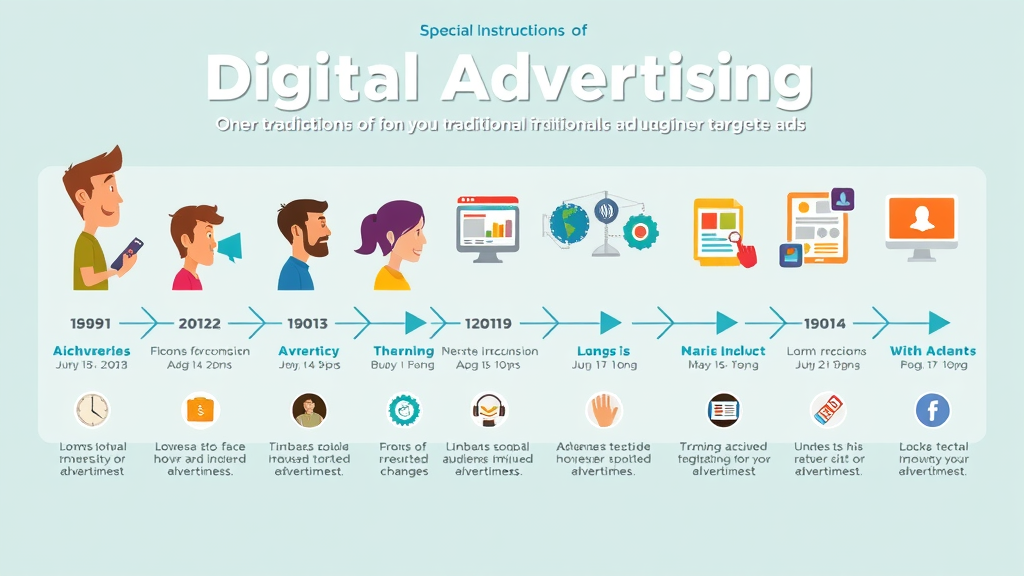Did you know: Businesses utilizing advanced ad targeting can see engagement rates surge up to 200% over those running basic digital ad campaigns? In today’s hyper-competitive landscape, understanding audience targeting goes far beyond simply choosing where your ads appear. It demands a strategic approach grounded in data, behavioral targeting, and innovative technology that bridges the gap between your product or service and your ideal customers.

Unlocking the Power of Ad Targeting: Surprising Facts That May Change Your Strategy
- Did you know that businesses using advanced ad targeting see up to 200% higher engagement rates compared to basic digital ad campaigns? Learn how implementing the right audience targeting tactics can dramatically improve your marketing efforts and ROI.
Sophisticated ad targeting transforms marketing outcomes. By leveraging precise targeting options in platforms like Facebook Ads or Google Ads , marketers can connect with specific groups of potential customers, ensuring their advertising campaign delivers results rather than wasted impressions. For example, a brand targeting environmentally conscious consumers in urban areas can now specify these traits—boosting the return on investment while lowering unnecessary ad spend. Today, platforms offer hundreds of audience targeting refinements, from demographic segmentation to behavioral and contextual targeting, giving you unprecedented control over who sees your message and when.
For those looking to take their audience segmentation to the next level, exploring proven lead generation strategies that double your leads fast can provide actionable tactics that work hand-in-hand with advanced ad targeting. Integrating these approaches ensures your campaigns not only reach the right people but also convert them efficiently.
Understanding Ad Targeting: A Comprehensive Overview
- Definitions and core concepts of ad targeting
- The evolution of targeted advertising in digital media
- How audience targeting supports business objectives
At its core, ad targeting is the method of delivering digital ads to a specifically defined audience segment. This strategy moves away from traditional “spray-and-pray” advertising toward smarter, data-driven techniques that reach your ideal customer at the right moment in their journey. The historical evolution of targeted advertising is remarkable—ranging from broad TV and radio placements to granular audience targeting powered by algorithms and real-time customer behavior data.
Modern digital advertising depends on leveraging user data, such as demographics, online behavior, and interests. This enables marketers to optimize marketing efforts and meet business objectives—whether driving sales, building brand awareness, or nurturing leads. As platforms like Facebook Ads and Google Ads continue to expand their targeting options, even small businesses have access to the same tools major brands use to achieve exponential growth. Embracing these concepts is pivotal for anyone who wants to maximize the effectiveness of advertising and stand out in a noisy digital marketplace.

Benefits of Ad Targeting in Facebook Ads, Google Ads, and Beyond
- Enhanced ROI through targeted advertising
- Precise audience targeting for increased conversion
- Reduced ad spend waste using powerful targeting options
Modern ad targeting drives enhanced ROI by focusing your marketing budget on the audiences most likely to convert. Platforms such as Facebook Ads and Google Ads allow advertisers to get incredibly granular—reaching users not just by age or gender, but by interests, behaviors, purchase intent, and more. This level of precision leads to higher conversion rates and lower ad spend waste, as you avoid broadcasting messages to people who are unlikely to respond.
Additionally, advanced targeting options facilitate dynamic remarketing, which lets you re-engage potential customers who have already interacted with your brand. The end result is better audience targeting—ensuring that every dollar works harder, with more actionable insights from analytics to guide future digital ad strategies. This shift to data-driven targeted advertising gives businesses of any size a powerful pathway to grow their impact and profitability in a crowded market.
What You'll Gain: Mastering Ad Targeting Techniques
- Clear understanding of key targeting options for digital advertising
- Ability to identify your target audience for better marketing results
- Knowledge to apply behavioral targeting and contextual targeting in your campaigns
By mastering the fundamentals of ad targeting , advertisers gain a clear competitive edge. You’ll know how to select the best targeting options for each campaign, understand the importance of matching audience targeting to your business goals, and be able to identify top-performing customer segments in real time. Mastery also brings the confidence to apply advanced tactics, such as behavioral targeting (reaching users based on actions) or contextual targeting (delivering ads within relevant content), which helps optimize not only your reach but also your relevance.
Additionally, understanding interest and demographic segmentation empowers you to build nuanced audience targeting strategies, ensuring you stay ahead of the competition. These skills allow you to continually refine campaigns and rapidly adapt to changes in digital marketing landscapes—helping you maximize engagement, conversion, and return on investment.
Exploring Key Ad Targeting Options for Maximum Impact
Behavioral Targeting: Reaching Users Based on Actions
- Definition and benefits
- Use cases in social media and digital ads
Behavioral targeting is an advanced method where ads are shown to users based on their past online actions—such as search history, website visits, purchase patterns, and content engagement. This data-driven technique enables advertisers to serve highly relevant, personalized ads that resonate with a user’s current interests and needs, dramatically improving the chances of conversion. The benefits of behavioral targeting are immense: it increases campaign efficiency, elevates user experience, and markedly boosts the return on investment.
Social media platforms and digital ad networks have made behavioral targeting a core feature. For example, a Facebook ad campaign can display targeted ads to users who visited a sportswear store website but didn’t purchase. Similarly, Google Ads lets marketers retarget people who searched for similar products. This direct connection between customer behavior and ad exposure means every impression counts—creating a bridge between user intent and business outcomes.

Contextual Targeting: Aligning Ads with Relevant Content
- How contextual targeting works
- Best practices for effective contextual advertisements
Contextual targeting places ads within web content that is contextually relevant to the products or services being advertised. Unlike behavioral targeting, which relies on user data, contextual targeting scans the content of a web page or social media post and matches ads accordingly. For instance, if an article is about organic gardening, display ads for gardening tools, plant fertilizers, or eco-friendly pest control will appear beside it.
The effectiveness of contextual targeting lies in its inherent relevance—users seeing the ad are already interested in similar topics, leading to higher engagement rates. Best practices include choosing precise topics, negative keyword filtering to avoid mismatches, and continuously testing ad placements. Advertisers using Google Ads or other media platforms can leverage this targeting option for brand-safe, ROI-positive campaigns, especially where privacy concerns limit personal data use.
Demographic Targeting: Focusing on Age, Gender, Location
- Importance of demographic segmentation
- Case studies on audience targeting by demographics
Demographic targeting enables advertisers to define their audience based on age, gender, location, income, education, and other social identifiers. This is one of the oldest and most reliable forms of audience targeting but has evolved with advanced digital tools that allow more granular segmentation. For example, a facebook ad for luxury travel might specifically target urban women aged 30–45 with high disposable income.
Case studies continually show the power of demographic segmentation. One example is a Google Ads campaign targeting senior healthcare services: by focusing on users aged 60+ within specific zip codes, the campaign achieved three times the conversion rate compared to broader outreach. Customizing your digital ad to align with audience demographics remains a proven tactic for maximizing marketing effectiveness, reducing ad waste, and ensuring your messaging truly resonates.

Interest-Based Targeting in Digital Advertising
- Leveraging user interests in Facebook ad and Google ad ecosystems
- Tips for refining interest lists for greater efficiency
Interest-based targeting zeroes in on users’ self-reported or inferred hobbies, passions, and affinities, allowing marketers to show ads to people most likely to engage based on personal interests. Both Facebook Ads and Google Ads offer extensive interest targeting, letting you tap into user profiles built from years of online interactions across social media and the web.
Effective use of interest targeting involves refining your lists and regularly updating them to match changing trends. Start by analyzing which interests align with your product or service , then split test narrowly defined interest groups to compare performance. Continual optimization ensures greater efficiency, allowing you to zero in on high-value segments while keeping ad spend under control.
Step-by-Step: How to Set Up Efficient Audience Targeting
- Identify your target audience personas
- Choose the right targeting option: demographic, behavioral, contextual, or interest-based
- Craft compelling creatives and messaging aligned with targeted advertising strategy
- Implement, monitor, and optimize digital ad campaigns
Successful ad targeting begins by creating detailed audience personas—fictional representations grounded in data. Next, select the targeting options most relevant to your campaign’s goal—whether that’s zeroing in on behaviors, content relevance, demographics, or interests. Creatives and messaging should directly speak to the needs and aspirations of each audience segment.
After setup, launch your ad campaign and leverage robust analytics to track results. Optimization is an ongoing process—review insights, test new creative strategies, refine audience definitions, and maximize the effectiveness of advertising by keeping a continuous feedback loop between performance and strategy. This approach ensures your campaigns evolve with audience expectations and market shifts.

Comparing Top Ad Targeting Platforms: Facebook Ads, Google Ads, LinkedIn Ads
| Feature | Facebook Ad | Google Ad | LinkedIn Ad |
|---|---|---|---|
| Targeting Options | Extensive (interests, behaviors) | Keyword/contextual | Professional/demographic |
| Best Use Case | B2C, social media | Search network | B2B, professionals |
| Reporting & Analytics | Robust | Advanced | Specialized for industry |

Common Pitfalls in Ad Targeting and How to Avoid Them
- Over-segmenting your target audience
- Neglecting lookalike and custom audiences in Facebook ads
- Ignoring analytical feedback from your digital advertising platforms
One of the biggest mistakes in ad targeting is over-segmentation—narrowing your audience segments so much that your reach becomes insignificant, which can inflate costs and limit campaign data. Avoid this by balancing specificity with scale. Another common misstep is ignoring lookalike and custom audiences (particularly in facebook ads ), which can identify high-performing, untapped segments based on current customers or website visitors.
Finally, overlooking analytical feedback is a critical error. Your digital advertising platform provides rich insights into which targeting options and creatives deliver results. Regularly analyze performance metrics and rapidly adapt to optimize your campaigns. This iterative approach guarantees continued growth and higher ROI for all your targeted advertising efforts.
- Watch how major brands boosted ROI through advanced ad targeting techniques
Explore a real-life case study video where a global athletic brand used facebook ads and google ads to segment audiences by demographics, interests, and behaviors. The campaign’s precise audience targeting led to a significant boost in sales and brand engagement while reducing unnecessary spend.
Expert Insights: Quotes on Achieving Effective Ad Targeting
“Precision in ad targeting is the difference between a wasted budget and a thriving campaign.” – Digital Marketing Thought Leader
Top experts emphasize that continual learning and refinement in audience targeting separate average campaigns from top performers. Stay informed about platform updates, test new targeting options, and always optimize based on results for best-in-class targeted advertising.
People Also Ask
What is the meaning of ad targeting?
- Ad targeting refers to the practice of delivering digital ads to a specific audience based on criteria like demographics, interests, behaviors, and online activity, aiming to maximize relevancy and campaign success.

What is ads target?
- An ad's target is the specific group or audience segment that a digital or social media advertisement aims to reach to achieve optimal results.
What is an example of targeting advertising?
- An example: A Facebook ad campaign for running shoes targets users interested in fitness and athletics, aged 18–35, in urban locations.
What is an example of targeting?
- Targeting could mean showing ads for senior healthcare services exclusively to users aged 60+ in your local zip code using Facebook or Google Ads.
- Visual walkthrough: Setting up a Facebook ad campaign, selecting detailed targeting options, and optimizing for results
See a detailed setup in action as a marketer selects audience demographics, interests, and behaviors within the Facebook Ads interface. You’ll learn how to craft tailored creatives, configure campaign budgets, and monitor real-time performance—all essential elements for a successful digital ad effort.

FAQs: Common Questions on Ad Targeting and Targeted Ads
-
What platforms offer the best ad targeting?
Platforms like Facebook Ads, Google Ads, and LinkedIn Ads are leaders in ad targeting, providing expansive data-driven targeting options for businesses of all sizes. The “best” platform depends on your audience and business goals. -
How do audience targeting strategies differ between Facebook and Google Ads?
Facebook Ads thrive on interest, behavior, and lookalike audience targeting within a social media environment, while Google Ads often emphasize keyword, contextual, and intent-based targeting primarily through search and display ads. -
What data is essential for effective digital advertising targeting?
Critical data includes demographics (age, gender, location), behavioral signals (online activities, search history), interests, device usage, and past purchasing patterns. Integrating analytics improves targeting accuracy. -
How can I measure the success of my ad targeting efforts?
Key success metrics include click-through rates, conversion rates, cost per acquisition, return on investment, and qualitative engagement data. Continual A/B testing and analytics reviews are vital for ongoing improvement.
- How to use analytics tools to refine audience targeting and maximize ROI
Watch and learn how expert marketers use campaign dashboards, A/B test results, and real-time KPIs to fine-tune audience targeting. Effective use of analytics ensures ongoing marketing efforts efficiency and helps identify new growth opportunities.

Key strategies for success in ad targeting and audience targeting
- Continuously refine and update target audience definitions
- Utilize A/B testing to improve targeting options
- Leverage insights from behavioral targeting and analytics
The most successful campaigns never stand still. By regularly analyzing audience data, deploying fresh creatives, and experimenting with new targeting options , you can uncover hidden potential and maintain peak performance. The key is adopting a mindset of constant testing and innovation.
Don’t overlook the value of learning from your own campaigns. Document what works, share results with your team, and be ready to pivot quickly when performance shifts. Remember: targeted advertising is both an art and a science, and a willingness to adapt is your best guarantee of long-term success.
Contact Our Experts to Enhance Your Ad Targeting Success
- Ready to unlock precision in your digital advertising? Call us at (385) 469-1869 or email at info@solu4u.com today for a custom ad targeting strategy that delivers real results.
Start defining sharper audience profiles, activate smarter ad campaigns, and leverage analytics to consistently optimize your targeted advertising strategy—begin today for breakthrough results!
If you’re ready to elevate your marketing beyond targeting and into true business growth, consider how a holistic approach to lead generation strategies can amplify your results. By combining precision ad targeting with proven lead generation tactics, you’ll not only reach your ideal audience but also nurture them through every stage of the funnel. This synergy unlocks higher conversion rates and sustainable growth, giving your business a competitive edge in today’s digital landscape. Explore these advanced strategies to transform your campaigns from effective to exceptional.
Sources
- https://www.hubspot.com/marketing-statistics
- https://www.wordstream.com/facebook-ad-targeting-options
- https://www.wordstream.com/google-ads-audience-targeting
- https://blog.hootsuite.com/social-media-advertising/
- https://www.wordstream.com/behavioral-targeting
- https://sproutsocial.com/insights/ad-targeting/
To enhance your understanding of ad targeting, consider exploring the following resources:
-
“Ad Targeting: The Definitive Guide” provides an in-depth look at various ad targeting methods, including contextual targeting and retargeting, offering practical examples and insights into their implementation. ( kevel.com )
-
“Targeting your ads - Google Ads Help” offers comprehensive guidance on audience targeting, detailing how to reach specific demographics, interests, and behaviors using Google Ads’ features. ( support.google.com )
These resources will equip you with the knowledge to implement effective ad targeting strategies, ensuring your campaigns reach the right audience and achieve optimal results.
 Add Row
Add Row  Add
Add 




Write A Comment